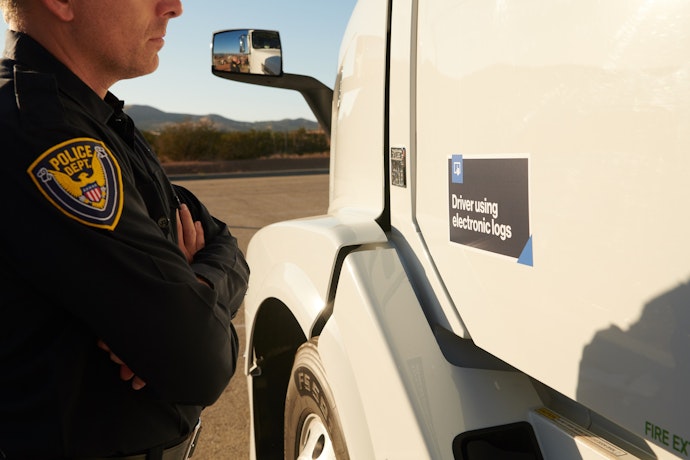How Smart Video Fuels Smart Business
Learn how video solutions with intelligent analysis capabilities can help benefit your drivers and enhance safety programs.
Read more
Not so long ago, trucking companies were using Automatic Onboard Recording Devices (AOBRDs). But, since December 16, 2019, a switch to Electronic Logging Devices (ELDs) has been required. For most fleets, that switch might seem like a distant memory. But ELDs are a very real facet of everyday fleet life. Here’s a primer on common myths that still persist, the benefits your organization can reap from ELD use, and the newest rules to keep in mind.
For the majority of commercial truck drivers, the new Electronic Logging Device mandate is a must. ELD regulations apply to most motor carriers in the United States, and to Canada- and Mexico-domiciled drivers, currently required to maintain records of duty status (RODS). In general, if a commercial vehicle requires a USDOT number, it also needs an ELD.
Contrary to popular belief, ELD devices do not automatically report HOS violations. Only carriers can access the driver log files. The government and law enforcement do not have direct access to vehicle location data or hours of service violations. However, when requested during a roadside inspection or a compliance audit, ELD data can be quickly transferred to the government to comply with the law.
Once a vehicle is in motion, an ELD will automatically assign a driver the appropriate status (i.e. "driving" or "on duty"). The driver does not need to interact with the ELD except to log in and change their status to "off duty" or "in sleeper berth."
The evidence is growing in favor of how ELDs can actually improve driving behavior. In fact, research has shown that trucks equipped with an ELD reduced their total crash rate by 11.7% and lowered their preventable crash rate by 5.1%.1 While drivers may still need to identify special driving categories like yard movements or personal conveyance, other distractions are reduced significantly so that drivers can focus on what they do best: drive.
Compared to other operational expenses like fuel, maintenance and equipment, ELDs are a relatively low-cost solution. Prices have dropped considerably over the years since ELDs were first introduced, and there have been a number of notable improvements in the technology.
Use of a reliable ELD is a firm step towards both time and cost savings. It reduces burdensome paperwork and manual processes and gives more immediate visibility into driver status and hours, which helps in better utilization of resources. Getting drivers out of the yard with the right loads, at the right time and to the right destination goes a long way towards lowering operational costs and increasing profitability.
This, too, is false. ELD technology can collect a whole lot more. For example, an ELD can capture and report vehicle metrics and driver safety data, as well as provide electronic vehicle inspections assistance, navigation support and job management tools.
As part of an ELD, these fleet management features can help managers support drivers in their daily routines. Drivers will gain more control over their time, letting them create, edit and manage their own hours; plus, today’s newer ELDs integrate within other key telematics technologies and provide drivers with even more ways to stay compliant. In addition to HOS compliance tools, fleet managers gain near real-time driver feedback, driver vehicle inspection reporting (DVIR) and IFTA mileage reporting.
Hours previously spent dealing with paper logbooks to manually log hours can now be used for training and development. With an ELD, drivers can simply interact with the system, get on the road as quickly as possible and let technology take care of the rest. So, the extra time invested in training will yield significant rewards down the road.
ELDs help you gain better oversight into driver behaviors (hard braking, idling), vehicle maintenance and inspection issues so you can work to improve overall fleet safety and better meet compliance standards.
Monitoring avoidable expenses like HOS violations, unnecessary vehicle maintenance and safety-related fines can help you enforce best practices by encouraging drivers to operate safely and efficiently, reducing expenditures and improving your bottom line.
With the ELD mandate came newer violations that could add cost and time to operations this year and into the future. The following are some of the latest violations to keep in mind:
Find out how you can use an ELD to intelligently manage your fleet. Here’s our free in depth guide.
Source:
1 - https://ntl.bts.gov/lib/51000/51800/51846/13-059 Evaluating_the_Potential_Safety_Benefits_of_Electronic_HOS--Full_Report.pdf




Find out how our platform gives you the visibility you need to get more done.
Learn how video solutions with intelligent analysis capabilities can help benefit your drivers and enhance safety programs.
Read moreAre you ready for vehicle tracking? Go through our checklist to learn the signs you’re ready to add fleet tracking to...
Read moreTechnology adoption helps fleets navigate operational obstacles. Learn what fleet management industry technology trends...
Read moreLearn how telematics can lead to operational improvements.
Read more
Get your free 2024 Fleet Technology Trends Report and see how organizations are: